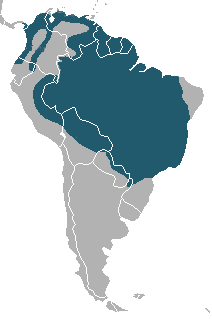Our website is made possible by displaying online advertisements to our visitors.
Please consider supporting us by disabling your ad blocker.
Bush dog
| Bush dog[1] | |
|---|---|

| |
| Bush dog at Prague Zoo | |
| Scientific classification | |
| Domain: | Eukaryota |
| Kingdom: | Animalia |
| Phylum: | Chordata |
| Class: | Mammalia |
| Order: | Carnivora |
| Infraorder: | Cynoidea |
| Family: | Canidae |
| Subfamily: | Caninae |
| Tribe: | Canini |
| Genus: | Speothos |
| Species: | S. venaticus
|
| Binomial name | |
| Speothos venaticus (Lund, 1842)
| |
| Subspecies | |
| |

| |
| Bush dog range | |
The bush dog (Speothos venaticus) is a canine found in Central and South America.[1][2] In spite of its extensive range, it is very rare in most areas except in Suriname, Guyana and Peru;[2][4] it was first described by Peter Wilhelm Lund from fossils in Brazilian caves and was believed to be extinct.[4]
The bush dog is the only extant species in the genus Speothos,[1] and genetic evidence suggests that its closest living relative is the maned wolf of central South America[5] or the African wild dog.[6] The species is listed as Near Threatened by the IUCN.[7][8][9]
In Brazil, it is called cachorro-vinagre ('vinegar dog') and cachorro-do-mato ('bush dog'). In Spanish-speaking countries, it is called perro vinagre ('vinegar dog'), zorro vinagre ('vinegar fox'), perro de agua ('water dog'), and perro de monte ('shrub or woodland dog').
- ^ a b c Wozencraft, W. C. (2005). "Order Carnivora". In Wilson, D. E.; Reeder, D. M. (eds.). Mammal Species of the World: A Taxonomic and Geographic Reference (3rd ed.). Johns Hopkins University Press. ISBN 978-0-8018-8221-0. OCLC 62265494.
- ^ a b c DeMatteo, K.; Michalski, F.; Leite-Pitman, M. R. P. (2011). "Speothos venaticus". IUCN Red List of Threatened Species. 2011: e.T20468A9203243. doi:10.2305/IUCN.UK.2011-2.RLTS.T20468A9203243.en. Retrieved November 19, 2021.
- ^ "Appendices". CITES. Retrieved January 14, 2022.
- ^ a b Cite error: The named reference
Beiseigel2005was invoked but never defined (see the help page). - ^ Wayne, R. K.; et al. (1997). "Molecular systematics of the Canidae". Systematic Biology. 46 (4): 622–653. doi:10.1093/sysbio/46.4.622. PMID 11975336.
- ^ Nyakatura, K.; et al. (2012). "Updating the evolutionary history of Carnivora (Mammalia): a new species-level supertree complete with divergence time estimates". BMC Biology. 10 (12): 12. doi:10.1186/1741-7007-10-12. PMC 3307490. PMID 22369503.
- ^ Beisiegel, B.M. (2009), "First camera trap record of bush dogs in the state of Sao Paulo, Brazil" (PDF), Canid News, vol. 12, no. 5, S2CID 41021664, retrieved March 12, 2024
- ^ Heft, Jeremy (June 12, 2021). "How Do Dogs Help With Bush Dog Conservation". WolfCenter.org. Wolf Education and Research Center. Retrieved April 2, 2023.
- ^ DeMatteo, Karen. "Using a survey of carnivore conservationists to gain new insight into the ecology and conservation status of the bush dog" (PDF). Canids.org. SSC Canid Specialist Group. Retrieved April 2, 2023.
Previous Page Next Page



